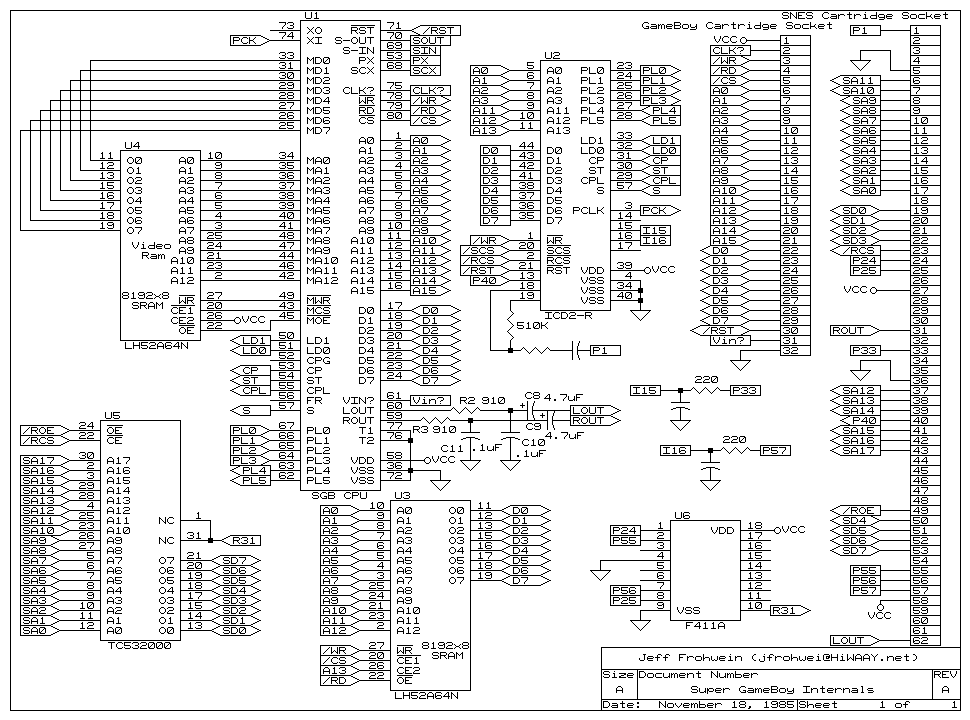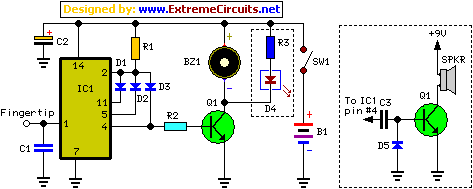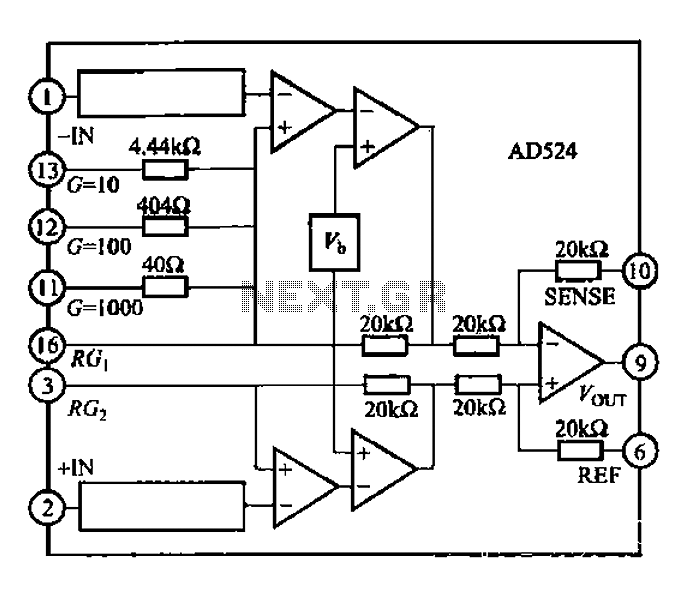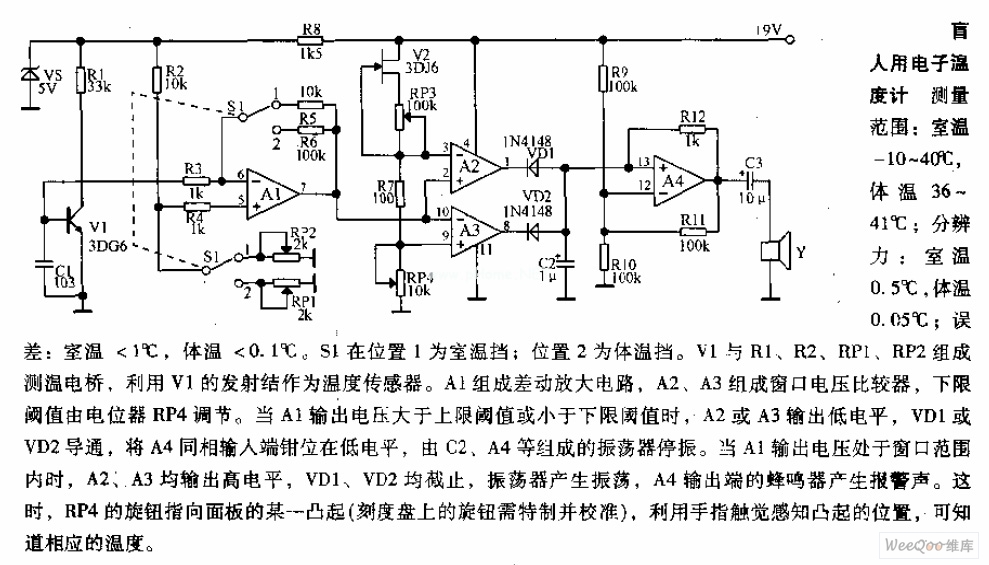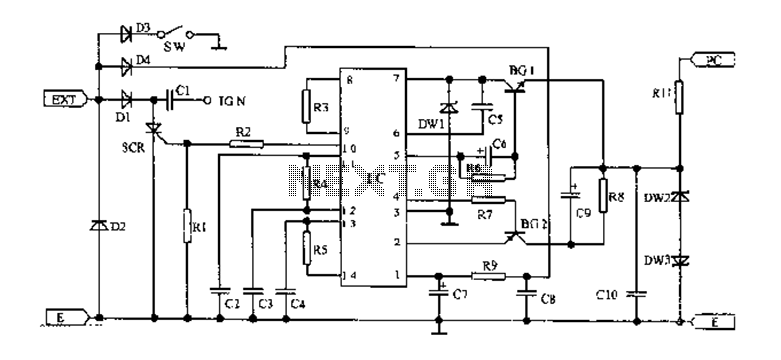
Electronic 7-Digit Combination Lock
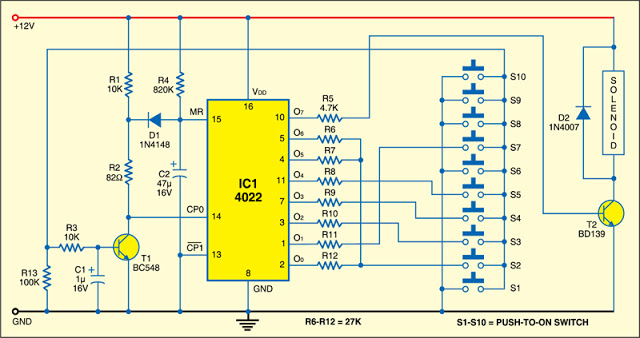
This 7-digit combination lock can be easily hard-wired for any combination that you choose. The circuit utilizes a 4-bit, divide-by-8 Johnson counter (IC1), ten push button switches, and an NPN transistor (T1). Upon power-on, capacitor C2 connected to pin 15 of IC1 charges to a high level through an 820-kilo-ohm resistor, maintaining the counter in a reset state. In this condition, output O0 (pin 2) of counter IC1 is high, while all other outputs remain low. When switch S2 is pressed, transistor T1 conducts, and capacitor C2 discharges through diode D1 and resistor R2, releasing the counter's reset input. Upon releasing S2, T1 turns off, and its collector is pulled high, generating a rising edge on the counter's input clock pin 14. Capacitor C1 and resistor R3 in the base circuit of transistor T1 form a simple filter to prevent switch contact bounce from generating multiple clock pulses on pin 14 of IC1. The clock pulse advances IC1's count by one, causing O0 to go low and O1 to go high. Consequently, switch S7 must be pressed next, as it is wired to output O1. The maximum time for capacitor C1 to charge to a logic high level dictates the maximum interval allowed between switch presses; otherwise, the counter will reset. When all switches are pressed in the correct sequence (S2-S7-S3-S4-S5-S2-S2 as indicated), output O7 (pin 10) of the counter goes high for approximately ten seconds. This output is connected to driver transistor T2, which activates the solenoid valve to unlock the mechanism. The circuit should be assembled on a common PCB and housed in a plastic cabinet. The solenoid valve should be connected to the circuit using flexible wire. Care should be taken during soldering to avoid short circuits. An IC base is recommended for ease of troubleshooting. The switches for opening the lock should be positioned at the top of the plastic case.
The 7-digit combination lock circuit is designed for reliable operation and ease of use. The heart of the system is the 4-bit Johnson counter (IC1), which counts the number of valid button presses in a predetermined sequence. The ten push button switches are strategically arranged to allow the user to input the combination. Each switch corresponds to a specific output of the counter, facilitating the lock mechanism's activation when the correct sequence is entered.
The reset mechanism is crucial for ensuring the security of the lock. Capacitor C2's charging through the 820-kilo-ohm resistor establishes a stable initial state. When a button is pressed, the discharge of C2 through diode D1 and resistor R2 allows the counter to exit the reset state, enabling it to begin counting valid inputs. The filtering action of capacitor C1 and resistor R3 is essential to prevent false triggering due to mechanical bounce when the buttons are pressed, ensuring that each press is registered as a single event.
The output logic of the counter is designed to provide a clear indication of the current state. As each button is pressed in the correct order, the corresponding output transitions from high to low, allowing the system to track progress through the combination sequence. If the sequence is interrupted or if the time between presses exceeds the threshold defined by C1's charging time, the counter resets, enhancing security.
Upon successful entry of the complete sequence, output O7 activates for a duration of approximately ten seconds, providing ample time for the solenoid valve to actuate and unlock the mechanism. The use of a driver transistor (T2) ensures that the solenoid receives adequate current to operate effectively, further enhancing the system's reliability.
The physical assembly of the circuit on a PCB should be done with care to avoid shorts, and the use of an IC base allows for easy replacement and troubleshooting of the counter IC. The enclosure in a plastic cabinet not only protects the components but also provides a user-friendly interface with the switches positioned conveniently for operation. This combination lock circuit exemplifies a practical application of digital logic and electronic components in security technology.This 7-digit combination lock can be easily hard-wired for any combination that you choose. The circuit uses a 4-bit, divide-by-8 Johnson counter (IC1), ten push button switches and NPN transistor T1. At power-on, ` capacitor C2 connected to pin 15 of IC1 charges to high level through 820-kilo-ohm resistor, holding the counter in the reset state.
I n this condition, output O0 (pin 2) of counter IC1 is high, while all other outputs are low. When switch S2 is pressed, transistor T1 conducts and capacitor C2 discharges via diode D1 and resistor R2, releasing the counter`s reset input. When S2 is released, T1 cuts off and its collector is pulled high, generating a rising edge on the counter`s input clock pin 14.
Capacitor C1 and resistor R3 in the base circuit of transistor T1 form a simple filter to prevent switch contact bounce from generating multiple clock pulses on pin 14 of IC1. The clock pulse advances IC1`s count by one, so O0 goes low and O1 goes high. Therefore press switch S7 next, as it`s wired to output O1. The time required for capacitor C1 to charge to logic high level is the maximum time that can lapse between switches pressed.
Otherwise, the counter will reset. When all switches have been pressed in the correct sequence (S2-S7-S3-S4-S5-S2-S2 as shown), output O7 (pin 10) of the counter goes high for about ten seconds. This output is fed to driver transistor T2 to drive the solenoid valve and open the lock. Assemble the circuit on a common PCB and enclose in a plastic cabinet. Connect the solenoid valve to the circuit using a flexible wire. While soldering, take care to avoid shortings. Use IC base for ease of troubleshooting. Connect the switches for opening the lock at the top of the plastic case. 🔗 External reference
The 7-digit combination lock circuit is designed for reliable operation and ease of use. The heart of the system is the 4-bit Johnson counter (IC1), which counts the number of valid button presses in a predetermined sequence. The ten push button switches are strategically arranged to allow the user to input the combination. Each switch corresponds to a specific output of the counter, facilitating the lock mechanism's activation when the correct sequence is entered.
The reset mechanism is crucial for ensuring the security of the lock. Capacitor C2's charging through the 820-kilo-ohm resistor establishes a stable initial state. When a button is pressed, the discharge of C2 through diode D1 and resistor R2 allows the counter to exit the reset state, enabling it to begin counting valid inputs. The filtering action of capacitor C1 and resistor R3 is essential to prevent false triggering due to mechanical bounce when the buttons are pressed, ensuring that each press is registered as a single event.
The output logic of the counter is designed to provide a clear indication of the current state. As each button is pressed in the correct order, the corresponding output transitions from high to low, allowing the system to track progress through the combination sequence. If the sequence is interrupted or if the time between presses exceeds the threshold defined by C1's charging time, the counter resets, enhancing security.
Upon successful entry of the complete sequence, output O7 activates for a duration of approximately ten seconds, providing ample time for the solenoid valve to actuate and unlock the mechanism. The use of a driver transistor (T2) ensures that the solenoid receives adequate current to operate effectively, further enhancing the system's reliability.
The physical assembly of the circuit on a PCB should be done with care to avoid shorts, and the use of an IC base allows for easy replacement and troubleshooting of the counter IC. The enclosure in a plastic cabinet not only protects the components but also provides a user-friendly interface with the switches positioned conveniently for operation. This combination lock circuit exemplifies a practical application of digital logic and electronic components in security technology.This 7-digit combination lock can be easily hard-wired for any combination that you choose. The circuit uses a 4-bit, divide-by-8 Johnson counter (IC1), ten push button switches and NPN transistor T1. At power-on, ` capacitor C2 connected to pin 15 of IC1 charges to high level through 820-kilo-ohm resistor, holding the counter in the reset state.
I n this condition, output O0 (pin 2) of counter IC1 is high, while all other outputs are low. When switch S2 is pressed, transistor T1 conducts and capacitor C2 discharges via diode D1 and resistor R2, releasing the counter`s reset input. When S2 is released, T1 cuts off and its collector is pulled high, generating a rising edge on the counter`s input clock pin 14.
Capacitor C1 and resistor R3 in the base circuit of transistor T1 form a simple filter to prevent switch contact bounce from generating multiple clock pulses on pin 14 of IC1. The clock pulse advances IC1`s count by one, so O0 goes low and O1 goes high. Therefore press switch S7 next, as it`s wired to output O1. The time required for capacitor C1 to charge to logic high level is the maximum time that can lapse between switches pressed.
Otherwise, the counter will reset. When all switches have been pressed in the correct sequence (S2-S7-S3-S4-S5-S2-S2 as shown), output O7 (pin 10) of the counter goes high for about ten seconds. This output is fed to driver transistor T2 to drive the solenoid valve and open the lock. Assemble the circuit on a common PCB and enclose in a plastic cabinet. Connect the solenoid valve to the circuit using a flexible wire. While soldering, take care to avoid shortings. Use IC base for ease of troubleshooting. Connect the switches for opening the lock at the top of the plastic case. 🔗 External reference
